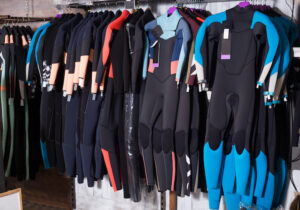Swimming in cold water can be a challenging, but rewarding activity. However, it’s important to have the right equipment to ensure your safety and comfort in the water. One key piece of equipment for cold water swimming is a wetsuit. A wetsuit helps to maintain your body temperature by trapping a layer of water next to your skin, which your body heats up.
In this article, we’ll explore the different factors to consider when choosing the best wetsuit for cold water swimming, including thickness, cut, fit, and closure. We’ll also provide tips on how to acclimate your body to the cold and minimize the effects of cold shock. With the right wetsuit and proper preparation, cold water swimming can be a fun and enjoyable activity.
You will learn about:
- how wetsuit helps to maintain body temperature in cold water
- Factors to consider when choosing a wetsuit include thickness, cut, fit, and closure
- Acclimating your body to the cold and minimizing the effects of cold shock can help ensure a safe and enjoyable cold water swimming experience.
Swimming in cold water – a challenge
Swimming in cold water can be a daunting prospect, especially if you’re not adequately prepared. One important piece of equipment for cold water swimming is a wetsuit. A wetsuit helps to keep your body temperature stable by trapping a layer of water next to your skin, which your body heats up. This layer of heated water acts as insulation, helping to keep you warm in cold water.
Another important aspect of cold water swimming is acclimatization. This means slowly getting your body used to the cold water, rather than jumping in all at once. A gradual process of acclimatization can help you build up your tolerance for cold water and reduce the risk of shock. One way to acclimatize is to start by dipping your toes in the water and gradually working your way up to longer swims. It’s also a good idea to swim with a buddy for safety, and to make sure you have a way to get out of the water if you start to feel too cold.
The right material for cold water temperatures
When it comes to materials for diving in cold water, neoprene is often the best choice. Neoprene is a synthetic rubber material that is used in wetsuits, drysuits, and other diving gear. It is known for its excellent insulation properties, making it ideal for use in cold water. Another important aspect of neoprene is its flexibility, which allows for a full range of movement while diving.
Other materials, such as trilaminate, can also be suitable for cold water diving, but neoprene is generally the most popular choice due to its combination of insulation and flexibility. It’s important to note that while the material of your diving gear is important, it’s also essential to have the proper thickness and fit to ensure optimal warmth and comfort in the water.
Let’s have a look on thermal reactions and wetsuit materials: it’s important to consider how well the material can retain heat. As mentioned earlier, neoprene is a good choice for this due to its insulation properties. However, it’s also important to consider how well the material can regulate heat. Some materials, such as neoprene, are more effective at regulating heat than others, which can be important in cold water diving. For example, if the water temperature is much colder than the air temperature, a wetsuit made of a material that regulates heat well can help prevent heat loss and keep the diver warm.
On the other hand, if the water temperature is much warmer than the air temperature, a wetsuit made of a material that regulates heat poorly may cause the diver to overheat. In general, it’s important to choose a wetsuit material that can both retain and regulate heat effectively in order to stay comfortable and safe while diving in cold water.
Why thickness matters
There are a few key factors to consider when choosing the best wetsuit for cold water swimming. The first is the wetsuit thickness. Wetsuits are usually made from neoprene, a synthetic rubber that provides excellent insulation. The thickness of the neoprene is measured in millimeters (mm) and generally ranges from 2mm to 7mm. In general, the thicker the wetsuit, the more insulation it will provide. However, thicker wetsuits can also be more cumbersome and less flexible, so it’s important to find the right balance for your needs.
The Importance of a Good Fit
In addition to thickness and material, the fit of the wetsuit is another crucial factor to consider. A wetsuit should fit snugly, but not so tightly that it restricts movement. Look for a wetsuit with a good range of motion in the shoulders and hips, as these are the areas that tend to be most restricted in a wetsuit. It’s also important to pay attention to the fit around the neck, wrists, and ankles, as these areas can allow water to enter the wetsuit and reduce its effectiveness as insulation.
When trying on wetsuits, be sure to wear a swimsuit or triathlon suit underneath to ensure that you get an accurate fit. It’s also a good idea to bring a friend or coach to help you get in and out of the wetsuit, as they can be difficult to put on and take off on your own.
Choosing the Right Closure
The final factor to consider when choosing a wetsuit is the type of closure. Wetsuits typically have either a back zipper or a front zipper. Back zippers are easier to get into and out of, but they can be more restrictive and may not provide as much flexibility as a front zipper. Front zippers, on the other hand, offer more flexibility and range of motion, but they can be more difficult to put on and take off.
When choosing between a back zipper and a front zipper wetsuit, consider the activity you’ll be participating in and your personal preferences. A back zipper wetsuit may be the best choice for a triathlon or long-distance swim, while a front zipper wetsuit may be more suitable for surfing or diving.
So if I need to find a warm wetsuit fast, what do I need to look for?
There are a few factors to consider when looking for the warmest wetsuit:
- Material: As mentioned earlier, neoprene is a good choice for insulation in cold water. Look for a wetsuit made of high-quality neoprene, as this will provide the best insulation.
- Thickness: The thickness of the wetsuit can also impact its warmth. In general, the thicker the wetsuit, the warmer it will be. However, it’s important to find a balance between warmth and flexibility. A wetsuit that is too thick may restrict your movement, making it more difficult to swim.
- Fit: The fit of the wetsuit is also important for warmth. A wetsuit that is too loose will allow water to circulate inside, reducing its insulating properties. On the other hand, a wetsuit that is too tight may restrict blood flow and make you colder. Look for a wetsuit that fits snugly but allows for a full range of movement.
- Layers: Some wetsuits are designed with multiple layers to provide extra warmth. These wetsuits may have a layer of insulation, such as fleece or thick neoprene, on the inside to trap heat.
- Other features: Some wetsuits have additional features designed to keep you warm, such as hoods, gloves, and boots. These can be useful in extremely cold water, but they may also restrict movement and make it harder to swim.
Overall, it’s important to find a balance between warmth, flexibility, and comfort when looking for the warmest wetsuit.
Conclusion: The best wetsuit for cold water swimming
The best will depend on your personal preferences and the specific conditions in which you’ll be swimming. It’s always a good idea to try on several different wetsuits before making a decision to ensure that you find the best fit and level of insulation for your needs. With the right wetsuit, cold water swimming can be a fun and rewarding activity.









